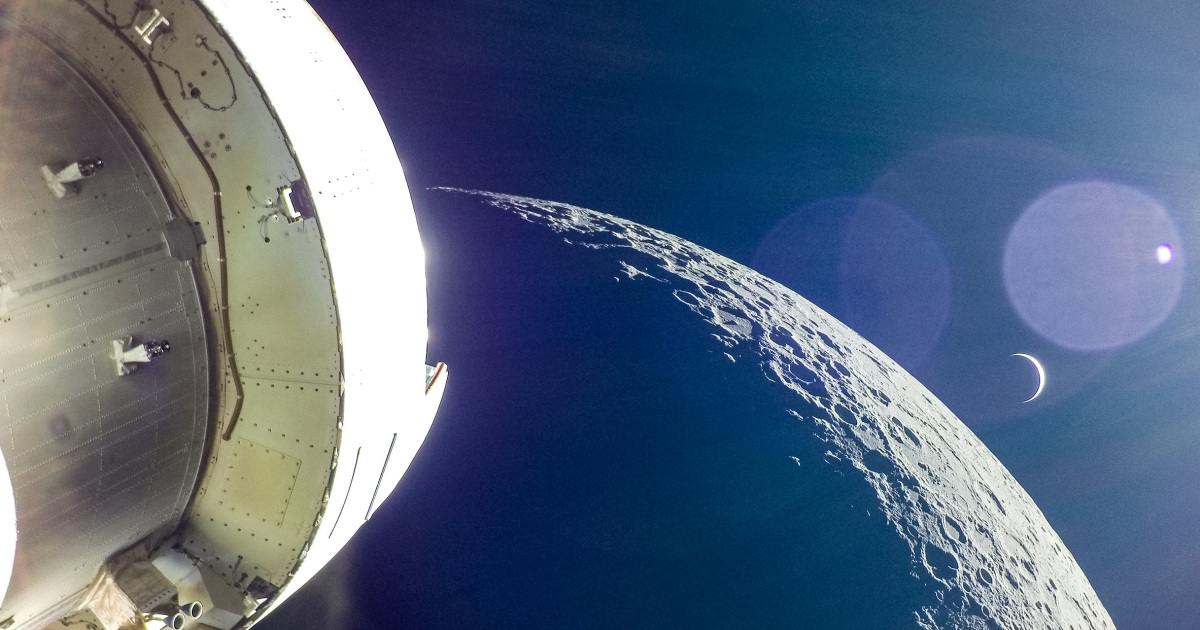By Denise Chow -
NBC News
Following a 26-day mission that took it on a historic trip around the Moon, NASA's next-generation Orion capsule has returned to Earth.
The return of the capsule marked the end of NASA's Artemis I test flight, the first launch and crucial expedition of the agency's new megatruck and space capsule for missions to the Moon.
During the weeks of its mission, the Orion capsule delivered stunning photos and videos of the lunar surface, along with spectacular "selfies" showing the spacecraft and the Moon with Earth visible in the background.
While orbiting the Moon, the capsule also flew over several landing sites for the Apollo missions, including those where the Apollo 12 and Apollo 14 astronauts landed.
NASA considers the Artemis I test flight
to lay the foundation for the
return of US astronauts to the Moon
.
It is also a key first step for
space exploration towards Mars
.
Artemis I was designed to test the Orion capsule and the massive Space Launch System rocket that puts it into orbit.
The 90-meter-tall rocket is more powerful than the Saturn V rockets NASA used to send astronauts to the moon more than 50 years ago during the landmark Apollo program.
Orion captured Earth behind the Moon on Wednesday.
POT
On flight day 17 of the Artemis I mission, Orion's Optical Navigation Camera captured this black-and-white image of our Earth.NASA
No humans traveled on the Artemis I mission, but future test flights - including the Artemis II expedition, originally scheduled for 2024 - will have astronaut passengers.
[How is the megarocket that NASA will launch on the Artemis I mission? An expert explains]
On this occasion,
a set of dummies equipped with various sensors
traveled in the Orion capsule to collect data on radiation exposure and other conditions of deep space travel.
The Artemis I flight also provided NASA with an important opportunity to
test Orion's heat shield
, designed to protect the spacecraft and its passengers from the extremely hot and high-temperature conditions generated upon entering Earth's atmosphere.
Orion traveled through the atmosphere
at a breakneck speed of 25,000 mph
, exposing the heat shield to temperatures of up to 5,000 degrees Fahrenheit, agency officials said.
For now, humans are not yet sent to the moon, but mannequins to prove that everything works well. NASA
A camera mounted on one of Orion's solar arrays took this image of the Moon.NASA
In addition to completing the maiden flight of the SLS rocket and Orion capsule, the Artemis I mission reached another milestone for NASA.
The capsule's wide orbit around the Moon helped it
travel farther than any spacecraft
designed to carry astronauts.
The new distance record was set on November 28, when the Orion spacecraft was about 270,000 kilometers from Earth.
The furthest manned flight title was held by the Apollo 13 mission, which came within 250,000 miles of Earth in 1970.
The Artemis I mission was launched into orbit on November 16 from NASA's Kennedy Space Center in Cape Canaveral, Florida.
The about $4.1 billion mission had been delayed several times to fix a faulty sensor and hydrogen fuel leaks, and because of two hurricanes that hit Florida: Ian in late September and Nicole in early November. .
Orion's splashdown was made in the Pacific.
POT
NASA is planning two more project Artemis test flights before launching regular missions to the Moon
to establish a lunar base camp
.
Artemis II will launch
four astronauts
in the Orion spacecraft on an expedition around the Moon.
A subsequent Artemis III mission
will carry the first women and the first person of color
to land on the lunar surface, according to NASA, which has not yet announced launch dates or who will make up the crews.

